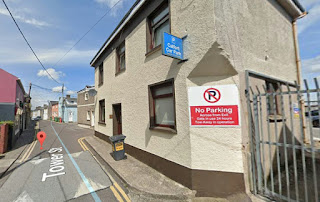Tower Street was once the site of Cat Fort, an old British militia barracks built in the 17th century as a twin defence barracks to Elizabeth Fort on Barrack Street. In 1920 it was being used by the Young Men's Christian Association (YMCA) as their store depot. This organisation was Unionist in it's inclinations and the Cork IRA suspected a spy network was working within its fold to decimate the Republican movement on Leeside.
Old map showing Elizabeth Fort on Barrack St and Cat Fort on Cat Lane which was later renamed Tower Street.
The YMCA became a target of the Cork No.1 Brigade and on the night of July 12th 1920 it's store depot at Cat Fort was raided by members of the First Brigade but, in the process a woman died.
Mary Anne Ward was a 61 year old who was living in the main guard house in the grounds of Cat Fort with her husband Arthur who worked there as YMCA caretaker. Mary, who gave birth to 15 children of 9 survived, previously lived with her family at No. 42 Douglas Street. When her husband retired from his work as an auctioneer they moved to Cat Fort when he took up what was to be a light position as YMCA caretaker.
The Ward home on Douglas Street, the green house on the left.
It was Sunday night just before midnight when approximately 20 volunteers raided Cat Fort. They took items such as a cinema projector and some British Army issued provisions. Before setting alight to the sheds and outhouses the Volunteers ordered the Wards to vacate the premises. As they were crossing the barrack square Mary Ward became distressed and collapsed. She was taken with the aid of her husband and some volunteers from Cat Fort to the public house across the street where she took her last breath.
"Cat Fort Car Park" across from Ma Dulleas pub now occupies the site of the long demolished Cat Fort.
In the inquest which followed Mrs Ward's death it was discovered she was suffering from heart disease and her cause of death was a cardiac attack.
Free Staters outside the YMCA office on South Mall.
Tower street was previously known as Cat Lane after the fort there. In 1865 local merchant Michael Callanan built the tower which now gives the street its name. His intentions were to have the tower as a focal point in a grand garden and race track in the area but, his plans were never fully realised and all that remains today are the stone walled gates and the tower which oversaw the raid on Cat Fort that Summer night in 1920.






















































